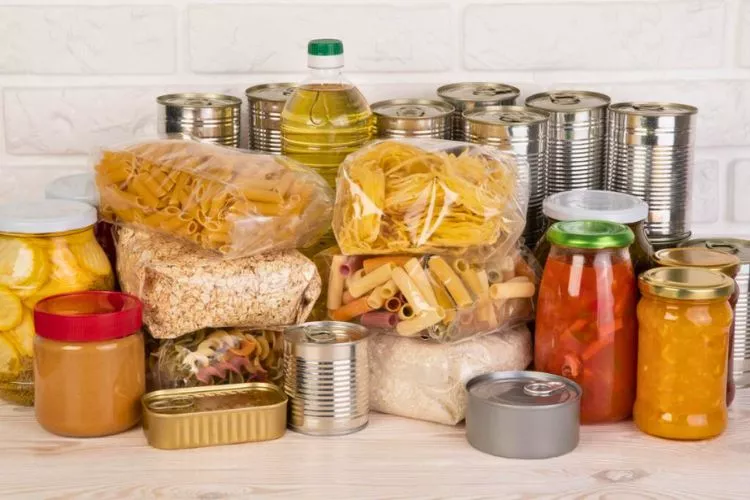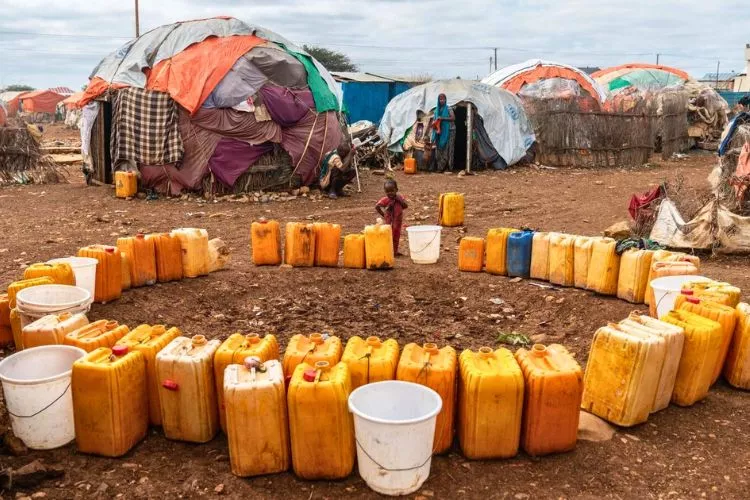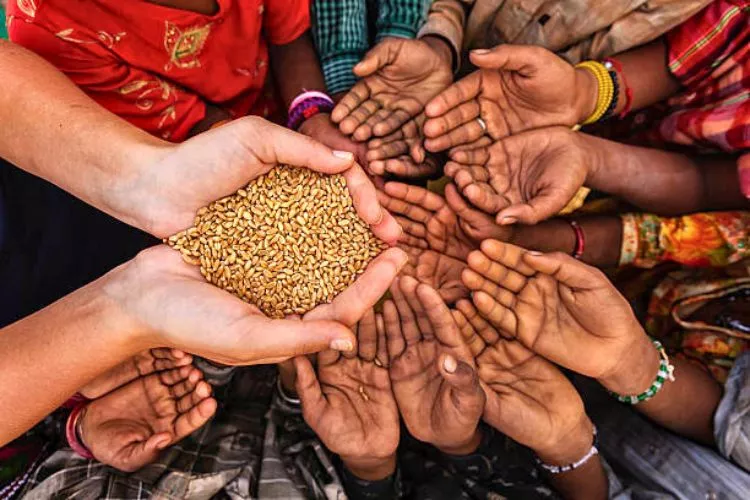Did you know nearly 9 million people died from famine-related causes between 1870 and 2010?
This alarming statistic underscores the devastating impact that famines can have on entire populations. That’s why I have decided to write this article on how to survive a famine to educate all of you.
A famine is an extreme scarcity of food, often caused by natural disasters, political instability, and economic factors.
In this article, I will explore the importance of being equipped with the knowledge and resources to survive a famine.
You’ll learn practical tips and strategies that could potentially save your life and the lives of your loved ones in the face of this dire situation. I will also delve into essential topics such as food and water storage, emergency supplies, and self-sufficiency.

How to survive a famine?
One of the most critical aspects of learning how to survive a famine is ensuring access to food and water.
Proper storage techniques can help you preserve your supplies for extended periods, allowing you to ration them effectively during times of scarcity.
Food Storage

- Stock up on non-perishable items: Prioritize purchasing food items with long shelf lives, such as canned goods, dried fruits, grains, and legumes. These can last for months or even years if stored correctly, providing a reliable source of nutrition during a famine.
- Use proper storage containers: Invest in airtight containers or vacuum-sealed bags to protect your food from exposure to air, moisture, and pests. Glass jars, plastic bins, and Mylar bags are all suitable options for long-term storage.
- Store food in a cool, dry place: Keep your food supplies in a dark, temperature-controlled environment, such as a pantry or basement. This can help prevent spoilage and prolong the shelf life of your stored items.
- Rotate your stock: Regularly check the expiration dates on your food supplies and consume items nearing expiration. Replace them with fresh supplies to maintain a constant stock of non-perishable food.
Water Storage

- Calculate your water needs: The average person requires at least one gallon of water daily for drinking and sanitation purposes. Determine how much water your household would need for a specific duration, such as a month or three months, and aim to store that amount.
- Use appropriate containers: Store water in food-grade, BPA-free containers for long-term storage. Avoid using containers that previously held chemicals, as they may contaminate your water supply.
- Treat stored water: To ensure the safety of your stored water, use water purification tablets or a small amount of household bleach. This can help eliminate potential contaminants and keep your water safe for consumption.
- Store water in a cool, dark place: Just like food, water should be stored in a temperature-controlled environment away from direct sunlight to prevent the growth of algae and bacteria.
Emergency Supplies
In addition to food and water, having a well-stocked emergency supply kit can be invaluable during a famine. This kit should contain essential items to help you survive and maintain a semblance of normalcy during a crisis.
- First aid kit: A comprehensive kit can help you treat minor injuries and illnesses at home, reducing the need to seek medical assistance during a famine when resources may be scarce.
- Hygiene supplies: Stock up on items such as soap, toothpaste, toilet paper, and sanitary products to maintain personal hygiene during a crisis.
- Cooking and heating equipment: Access to electricity and gas may be limited during a famine, so it’s essential to have alternative means of cooking and heating. Portable stoves, solar cookers, and fuel tablets are all viable options.
- Communication devices: In a widespread crisis, having a means of communication can be vital. Battery-operated or solar-powered radios and walkie-talkies can help you stay informed and connected with others.
- Tools and equipment: Basic tools such as a multi-tool, rope, duct tape, and a firestarter can be incredibly useful for various tasks and repairs during a famine.
Self-Sufficiency
Becoming self-sufficient is another crucial aspect of surviving a famine.
By relying less on external sources for food, water, and other necessities, you can increase your resilience and adaptability during times of crisis. Here are some strategies to help you achieve self-sufficiency:

- Grow your food: Cultivate a vegetable garden or start a small-scale farm to produce your food. Focus on planting drought-tolerant, nutrient-dense crops, and easy to store, such as potatoes, beans, and leafy greens. Learning how to preserve food through methods like canning, drying, and pickling can also help extend the shelf life of your harvest.
- Raise livestock: If you have sufficient space and resources, consider raising animals like chickens, rabbits, or goats for a sustainable source of protein. These animals can provide meat, eggs, and milk, contributing to a well-rounded diet during a famine.
- Harvest rainwater: Collecting rainwater can be an effective way to supplement your water supply. Set up a rainwater harvesting system with gutters, barrels, and filters to capture and store water for later use.
- Learn essential skills: Acquiring skills like gardening, animal husbandry, food preservation, and basic carpentry can significantly increase your self-sufficiency during a famine. Invest time in learning these skills and share your knowledge with your community to create a more resilient network of individuals.
- Develop a barter system: In times of crisis, traditional currency may lose its value, and resources like food, water, and tools may become more valuable. Establish relationships with neighbors and community members to trade goods and services, fostering a sense of cooperation and mutual support.
Surviving a famine requires preparation, resourcefulness, and adaptability. By implementing the strategies outlined in this article, you can better equip yourself and your loved ones to face the challenges of a famine and emerge stronger on the other side.
Famine foods examples
Famine foods are typically consumed as a last resort when conventional food sources are scarce or unavailable. They often contain wild plants, insects, and other unconventional food items. Here are more examples and details about famine foods:

- Nettles: Stinging nettles are a common famine food, especially in Europe. They can be cooked and consumed like spinach or made into soup. Nettles are rich in vitamins and minerals, including iron, calcium, and vitamin C.
- Seaweed: Various types of seaweed can be found along coastal regions and are often consumed during famine. Seaweed is high in vitamins, minerals, and iodine. It can be eaten raw, dried, or cooked in soups and stews.
- Grass: People have resorted to eating grass to stave off hunger in extreme situations. While grass is difficult for humans to digest, it can provide some nutrients and fiber.
- Tree bark: The inner bark of some trees, such as pine, can be eaten during famine. This inner bark, or cambium, is rich in nutrients and can be dried, ground into a powder, and mixed with other ingredients to make bread or porridge.
- Insects: In many cultures, insects are a regular diet. During times of famine, insects like locusts, crickets, and grasshoppers can be an essential source of protein and nutrients.
- Wild roots and tubers: Wild roots and tubers, such as dandelion roots, cattail roots, and wild yams, can be dug up, washed, and cooked. These provide essential carbohydrates and other nutrients during food scarcity.
- Acorns: Acorns from oak trees can be collected, leached to remove tannins, and ground into flour for making bread or porridge. They are a good source of carbohydrates, fats, and protein.
- Cactus: In arid regions, cactus pads and fruits can provide water and nutrients during times of famine. They can be eaten raw or cooked, providing vitamins, minerals, and fiber.
- Mushrooms: While some wild mushrooms are poisonous, others can be a valuable food source during famine. Proper identification is crucial to avoid toxic varieties. Edible mushrooms can provide protein, vitamins, and minerals.
It’s essential to note that many famine foods require specific preparation methods to be safe for consumption or to maximize their nutritional value.
Additionally, some of these foods may not be a sustainable long-term solution, but they can provide temporary relief during severe food scarcity.
What foods should I stockpile for survival?
When stockpiling survival food, consider the following categories of non-perishable items with long shelf lives:

- Grains and starches: These provide energy and can be stored for extended periods. Examples include rice, pasta, oats, quinoa, and flour.
- Protein sources: Protein is essential for maintaining muscle mass and overall health. Stock up on canned meats (e.g., tuna, chicken, and spam), beans, lentils, and freeze-dried or dehydrated meats.
- Fruits and vegetables: Canned, freeze-dried, or dehydrated fruits and vegetables can provide essential vitamins and minerals. Look for items like canned green beans, corn, peas, fruit cocktail, and dried fruits like raisins, apricots, and apples.
- Nuts and seeds: These are high in healthy fats and can be a good source of protein. Examples include almonds, peanuts, sunflower seeds, and chia seeds. Store them in airtight containers to prolong their shelf life.
- Powdered or canned dairy products: Powdered milk, evaporated milk, and canned cheese can provide calcium and other nutrients. They can also be used in various recipes to improve your meals’ taste and nutritional value.
- Cooking essentials: Stock up on cooking oils (e.g., olive oil, coconut oil), salt, sugar, honey, and spices to add flavor to your meals and preserve food.
- Snacks and comfort foods: Having familiar and enjoyable foods can help boost morale during a crisis. Consider granola bars, protein bars, trail mix, crackers, and chocolate.
- Emergency food supplies: Commercially available emergency food rations and freeze-dried meals can provide a balanced diet and are designed for long-term storage.
- Beverages: In addition to water, stock up on powdered drink mixes, instant coffee, and tea bags for variety and comfort.
- Special dietary needs: If you or a family member has specific dietary requirements, ensure that you stockpile appropriate food items to meet those needs (e.g., gluten-free, low-sodium, or allergen-free products).
Keep track of expiration dates when stockpiling food and rotate your supplies to ensure freshness. Invest in proper storage containers and store your food in a cool, dry place to prolong its shelf life.
Finally, consider learning food preservation techniques like canning, pickling, and dehydrating to further extend the longevity of your food supplies.
frequently asked questions (FAQs)
What did Irish people eat during famine?
During the Irish Potato Famine, also known as the Great Hunger, the primary food source for the Irish population was the potato, which was affected by a destructive plant disease called Phytophthora infestans. This disease caused widespread crop failure and severe food shortages. u003cbru003eAs a result, many Irish people had to rely on alternative food sources such as nettles, seaweed, and even grass to survive. The famine forced many Irish people to emigrate to other countries, mainly the United States, for better living conditions and food security.
Is cabbage a famine food?
Cabbage is not specifically considered a famine food, but it has been a staple in many cultures throughout history due to its hardiness, adaptability, and nutritional content. The history of cabbage dates back thousands of years, with the ancient Romans cultivating and consuming it for various purposes. u003cbru003eCabbage has also been a significant part of the Irish diet, particularly during the 19th century. Although cabbage might not be classified as a famine food, its affordability, availability, and nutritional value could make it a crucial food source during times of scarcity.
What single food can a human survive on?
No single food can provide all the necessary nutrients for a human to survive indefinitely. However, if one chooses a single food to survive on for an extended period, potatoes come close to providing a balance of essential nutrients. u003cbru003eThe nutritional profile is improved when combined with milk or butter, as it provides additional vitamins, minerals, and essential fatty acids. Remember that relying solely on a single food source is not recommended, as it can lead to nutritional deficiencies and health problems over time.
Conclusion:
Surviving a famine requires resourcefulness, adaptability, and knowledge of alternative food sources. By familiarizing oneself with local wild plants, insects, and unconventional food items, it’s possible to secure vital nutrients during times of scarcity.
Additionally, practicing efficient food storage, rationing, and preservation techniques can help stretch limited resources.
While no single food can sustain a person indefinitely, combining available resources and maintaining a balanced diet is crucial for survival. Ultimately, the key to overcoming a famine lies in our ability to adapt and make the most of the resources.


